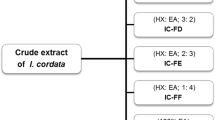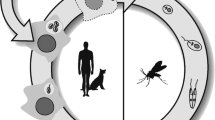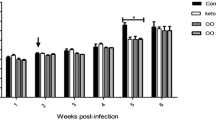Abstract
In this study, we are reporting antileishmanial activity of a marine sponge Haliclona exigua, belonging to phylum Porifera. The crude methanol extract and its three fractions were tested both in vitro and in vivo. The crude extract exerted almost complete inhibition of promastigotes at 50 μg/ml and 76.4 ± 6.5% inhibition of intracellular amastigotes at 100 μg/ml concentration with IC50 values of 18.6 μg/ml and 47.2 μg/ml, respectively. When administered to Leishmania donovani infected hamsters at a dose of 500 mg/kg × 5, p.o., it resulted in 72.2 ± 10.4% inhibition of intracellular amastigotes. At a lower dose (250 mg/kg), it exhibited 43.9 ± 5.1% inhibition. Among the fractions, highest antileishmanial activity both in vitro (>90%) and in vivo (60.9 ± 18.3%) was observed in n-butanol (soluble) fraction with IC50 values of 8.2 μg/ml and 31.2 μg/ml against promastigotes and intracellular amastigotes, respectively. Hexane fraction also showed comparatively good activity against both the stages of parasites in vitro but was moderately active in leishmania-infected hamsters. Chloroform fraction resulted in 45 ± 10.2% inhibition in vivo at a dose of 500 mg/kg × 5, p.o., whereas it was inactive in vitro. n-Butanol (insoluble) fraction was inactive both in vitro and in vivo. Araguspongin C, an alkaloid isolated from n-butanol (soluble) fraction exhibited moderate inhibition of promastigotes and intracellular amastigotes at 100 μg/ml but showed weak antileishmanial action in vivo. Our findings indicate that this marine sponge has the potential to provide new lead toward development of an effective antileishmanial agent and, hence, calls for more exhaustive studies for exploiting the vast world of marine resources to combat the scourge of several parasitic diseases.





Similar content being viewed by others
References
Bhosale SH, Jagtap TG, Naik CG (1999) Antifungal activity of some marine organisms from India, against food spoilage Aspergillus strains. Mycopathologia 147:133–138
Chan MC, Bulinski JC, Chang KP, Fong D (2003) A microplate assay for Leishmania amazonensis promastigotes expressing multimeric green fluorescent protein. Parasitol Res 89:266–271
Compagnone RS, Pina IC, Rangel HR, Dagger F, Suarez AI, Reddy MVR, Faulkner DJ (1998) Antileishmanial cyclic peroxides from the Palauan sponge Plakortis aff. angulospiculatus. Tetrahedron 54:3057–3068
Copp BR, Kayser O, Brun R, Kiderlen AF (2003) Antiparasitic activity of marine pyridoacridone alkaloids related to the ascididemins. Planta Med 69:527–531
Croft SL (2001) Monitoring drug resistance in leishmaniasis. Trop Med Int Health 6:1–7
Croft SL, Coombs GH (2003) Leishmaniasis—current chemotherapy and recent advances in the search for novel drugs. Trends Parasitol 19:502–508
Croft SL, Sundar S, Fairlamb AH (2006) Drug resistance in leishmaniasis. Clin Microbiol Rev 19:111–126
Dube A, Singh N, Sundar S, Singh N (2005) Refractoriness to the treatment of sodium stibogluconate in Indian kala-azar field isolates persists in in vitro and in vivo experimental models. Parasitol Res 96:216–223
Faulkner DJ (2001) Marine natural products. Nat Prod Rep 18:1–49
Fournet A, Munoz V (2002) Natural products as trypanocidal, antileishmanial and antimalarial drugs. Curr Top Med Chem 2:1215–1237
Guru PY, Agarwal AK, Singha UK, Singhal A, Gupta CM (1989) Drug targeting in Leishmania donovani infections using tuftsin bearing liposomes as drug vehicles. FEBS Lett 245:204–208
Haefner B (2003) Drugs from the deep: marine natural products as drug candidates. Drug Discov Today 8:536–544
Herwaldt BL (1999) Leishmaniasis. Lancet 354:1191–1199
Kamau SW, Grimm F, Hehl AB (2001) Expression of green fluorescent protein as a marker for effects of antileishmanial compounds in vitro. Antimicrob Agents Chemother 45:3654–3656
Kayser O, Kiderlen A, Croft S (2003) Natural products as antiparasitic drugs. Parasitol Res 90:S55–S62
Le Pape P, Zidane M, Abdala H, More M (2000) A glycoprotein isolated from the sponge, Pachymatisma johnstonii, has anti-leishmanial activity. Cell Biol Int 24:51–56
Marchan E, Arrieche D, Henriquez W, Crescente O (2000) In vitro effect of an alkaloid isolated from Amphimedon viridis (Porifea) on promastigotes of Leishmania mexicana. Rev Biol Trop 48(Suppl):31–38
Melby PC, Chandrasekar B, Zhao W, Coe JE (2001) The hamster as a model of human visceral leishmaniasis: progressive disease and impaired generation of nitric oxide in the face of a prominent Th1-like cytokine response. J Immunol 166:1912–1920
Murray HW (2004) Treatment of visceral leishmaniasis in 2004. Am J Trop Med Hyg 71:787–794
Nakao Y, Shiroiwa T, Murayama S, Matsunaga S, Goto Y, Matsumoto Y, Fusetani N (2004) Identification of renieramycin A as an antileishmanial substance in a marine sponge Neopetrosia sp. Marine Drugs 2:55–62
Plock A, Sokolowska-Kohler W, Presber W (2001) Application of flow cytometry and microscopical methods to characterize the effects of herbal drugs on Leishmania spp. Exp Parasitol 97:141–153
Rangel HR, Dagger F (1997) Antiproliferative effect of illimaquinone on Leishmania mexicana. Cell Biol Int 21:337–339
Rao KV, Santarsiero BD, Mesecar AD, Schinazi RF, Tekwani BL, Hamann MT (2003) New manzamine alkaloids with activity against infectious and tropical parasitic diseases from an Indonesian sponge. J Nat Prod 66:823–828
Rao KV, Kasanah N, Wahyuono S, Tekwani BL, Schinazi RF, Hamann MT (2004) Three new manzamine alkaloids from a common Indonesian sponge and their activity against infectious and tropical parasitic diseases. J Nat Prod 67:1314–1318
Sharma P, Rastogi S, Bhatnagar S, Srivastava JK, Dube A, Guru PY, Kulshreshtha DK, Dhawan BN (2003) Antileishmanial action of a plant Tephrosia pupurea and its fractions against experimental visceral leishmaniasis. Drug Dev Res 60:285–293
Sharma P, Singh N, Garg R, Haq W, Dube A (2004) Efficacy of human β-casein fragment (54–59) and its synthetic analogue compound 89/215 against Leishmania donovani in hamsters. Peptides 25:1873–1881
Singh N, Dube A (2004) Fluorescent Leishmania: applications to antileishmanial drug testing. Am J Trop Med Hyg 71:400–402
Sundar S (2001) Drug resistance in Indian visceral leishmaniasis. Trop Med Int Health 6:849–854
Venkateshwarlu Y, Reddy MVR, Rao JV (1994) Bis-1-oxaquinolizidine from the sponge Haliclona exigua. J Nat Prod 57:1283–1285
Yan HY (2004) Harvesting drugs from the seas and how Taiwan could contribute to this effort. Changhua J Med 9:1–6
Acknowledgments
The work was supported by the Department of Ocean Development, New Delhi, India. Our kind thanks are due to the Director of CDRI for encouragement and to Shri H. R. Mishra and Shri N. P. Mishra for technical assistance. The financial assistance in the form of fellowship by the Council of Scientific and Industrial Research (NS) and CDRI (AS) is gratefully acknowledged. This is CDRI communication no. 6899.
Author information
Authors and Affiliations
Corresponding author
Rights and permissions
About this article
Cite this article
Dube, A., Singh, N., Saxena, A. et al. Antileishmanial potential of a marine sponge, Haliclona exigua (Kirkpatrick) against experimental visceral leishmaniasis. Parasitol Res 101, 317–324 (2007). https://doi.org/10.1007/s00436-007-0469-z
Received:
Accepted:
Published:
Issue Date:
DOI: https://doi.org/10.1007/s00436-007-0469-z




